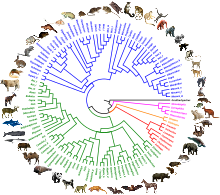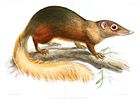
Xenarthra is a major clade of placental mammals native to the Americas. There are 31 living species: the anteaters, tree sloths, and armadillos. Extinct xenarthrans include the glyptodonts, pampatheres and ground sloths. Xenarthrans originated in South America during the late Paleocene about 60 million years ago. They evolved and diversified extensively in South America during the continent's long period of isolation in the early to mid Cenozoic Era. They spread to the Antilles by the early Miocene and, starting about 3 million years ago, spread to Central and North America as part of the Great American Interchange. Nearly all of the formerly abundant megafaunal xenarthrans became extinct at the end of the Pleistocene.

The treeshrews are small mammals native to the tropical forests of South and Southeast Asia. They make up the entire order Scandentia, which split into two families: the Tupaiidae, and the Ptilocercidae.

Placental mammals are one of the three extant subdivisions of the class Mammalia, the other two being Monotremata and Marsupialia. Placentalia contains the vast majority of extant mammals, which are partly distinguished from monotremes and marsupials in that the fetus is carried in the uterus of its mother to a relatively late stage of development. The name is something of a misnomer considering that marsupials also nourish their fetuses via a placenta, though for a relatively briefer period, giving birth to less developed young which are then nurtured for a period inside the mother's pouch. Placentalia represents the only living group within Eutheria, which contains all mammals more closely related to placentals than to marsupials.

Colugos are arboreal gliding mammals that are native to Southeast Asia. Their closest evolutionary relatives are primates. There are just two living species of colugos: the Sunda flying lemur and the Philippine flying lemur. These two species make up the entire family Cynocephalidae and order Dermoptera.

Afrotheria is a superorder of mammals, the living members of which belong to groups that are either currently living in Africa or of African origin: golden moles, elephant shrews, otter shrews, tenrecs, aardvarks, hyraxes, elephants, sea cows, and several extinct clades. Most groups of afrotheres share little or no superficial resemblance, and their similarities have only become known in recent times because of genetics and molecular studies. Many afrothere groups are found mostly or exclusively in Africa, reflecting the fact that Africa was an island continent from the Cretaceous until the early Miocene around 20 million years ago, when Afro-Arabia collided with Eurasia.
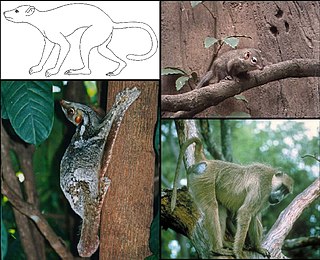
The Euarchonta are a proposed grandorder of mammals: the order Scandentia (treeshrews), and its sister Primatomorpha mirorder, containing the Dermoptera or colugos and the primates.

Glires is a clade consisting of rodents and lagomorphs. The hypothesis that these form a monophyletic group has been long debated based on morphological evidence. Two morphological studies, published in 2001 and 2003, strongly support the monophyly of Glires. In particular, the 2003 study reported the discovery of fossil material of basal members of Glires, particularly the genera Mimotona, Gomphos, Heomys, Matutinia, Rhombomylus, and Sinomylus. Their description, in 2005, helped to bridge the gap between more typical rodents and lagomorphs. Data published in 2001, based on nuclear DNA, supported Glires as a sister of Euarchonta to form Euarchontoglires, but some genetic data from both nuclear and mitochondrial DNA have been less supportive. A study, published in 2007, investigating retrotransposon presence/absence data unambiguously supports the Glires hypothesis. Studies published in 2011 and 2015 place Scandentia as a sister clade of the Glires, invalidating Euarchonta as a clade.
The Archonta are a now-abandoned group of mammals, considered a superorder in some classifications, which consists of these orders:

Laurasiatheria is a superorder of placental mammals that groups together true insectivores (eulipotyphlans), bats (chiropterans), carnivorans, pangolins (pholidotes), even-toed ungulates (artiodactyls), odd-toed ungulates (perissodactyls), and all their extinct relatives. From systematics and phylogenetic perspectives, it is subdivided into order Eulipotyphla and clade Scrotifera. It is a sister group to Euarchontoglires with which it forms the magnorder Boreoeutheria. Laurasiatheria was discovered on the basis of the similar gene sequences shared by the mammals belonging to it; no anatomical features have yet been found that unite the group, although a few have been suggested such as a small coracoid process, a simplified hindgut and allantoic vessels that are large to moderate in size. The Laurasiatheria clade is based on DNA sequence analyses and retrotransposon presence/absence data. The superorder originated on the northern supercontinent of Laurasia, after it split from Gondwana when Pangaea broke up. Its last common ancestor is supposed to have lived between ca. 76 to 90 million years ago.
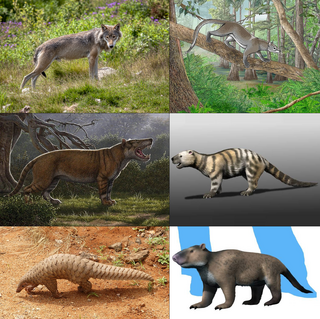
Ferae is a mirorder of placental mammals from grandorder Ferungulata, that groups together clades Pan-Carnivora, which includes modern carnivorans, and Pholidotamorpha, which includes pangolins.

Atlantogenata is a proposed clade of placental mammals containing the cohorts or superorders Xenarthra and Afrotheria. These groups originated and radiated in the South American and African continents, respectively, presumably in the Cretaceous. Together with Boreoeutheria, they make up Eutheria. The monophyly of this grouping is supported by some genetic evidence.

Zooamata is a proposal for a clade of mammals uniting the Ferae with the Perissodactyla.

Epitherians comprise all the placental mammals except the Xenarthra. They are primarily characterized by having a stirrup-shaped stapes in the middle ear, which allows for passage of a blood vessel. This is in contrast to the column-shaped stapes found in marsupials, monotremes, and xenarthrans. They are also characterized by having a shorter fibula relative to the tibia.

Boreoeutheria is a magnorder of placental mammals that groups together superorders Euarchontoglires and Laurasiatheria. With a few exceptions, male boreoeutherians have a scrotum, an ancestral feature of the clade. The sub-clade Scrotifera was named after this feature.
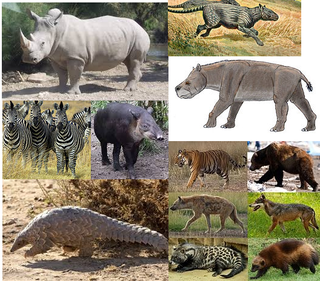
Pegasoferae is a proposed clade of mammals based on genomic research in molecular systematics by Nishihara, Hasegawa and Okada (2006).

Exafroplacentalia or Notolegia is a clade of placental mammals proposed in 2001 on the basis of molecular research.

Primatomorpha is a proposed mirorder of mammals containing the orders Dermoptera and Primates. Primatomorpha is sister to Scandentia, together forming the Euarchonta.

Scrotifera is a clade of placental mammals that groups together grandorder Ferungulata, Chiroptera (bats), other extinct members and their common ancestors. The clade Scrotifera is a sister group to the order Eulipotyphla based on evidence from molecular phylogenetics, and together they make superorder Laurasiatheria. The last common ancestor of Scrotifera is supposed to have diversified ca. 73.1 to 85.5 million years ago.
The 2000s witnessed an explosion of genome sequencing and mapping in evolutionarily diverse species. While full genome sequencing of mammals is rapidly progressing, the ability to assemble and align orthologous whole chromosomal regions from more than a few species is not yet possible. The intense focus on the building of comparative maps for domestic, laboratory and agricultural (cattle) animals has traditionally been used to understand the underlying basis of disease-related and healthy phenotypes.

Emma Caroline Teeling is an Irish zoologist, geneticist and genomicist, who specialises in the phylogenetics and genomics of bats. Her work includes understanding of the bat genome and study of how insights from other mammals such as bats might contribute to better understanding and management of ageing and a number of conditions, including deafness and blindness, in humans. She is the co-founder of the Bat1K project to map the genomes of all species of bat. She is also concerned with understanding of the places of bats in the environment and how to conserve their ecosystem.

